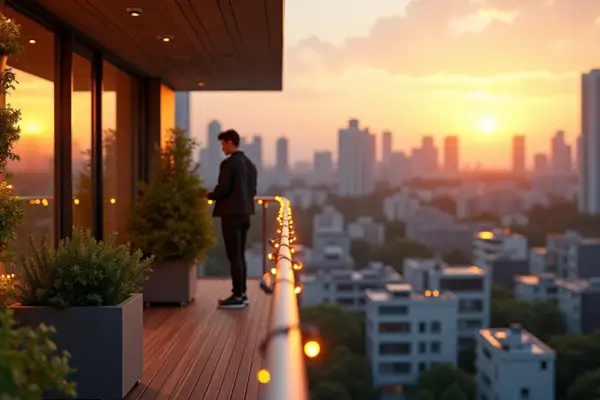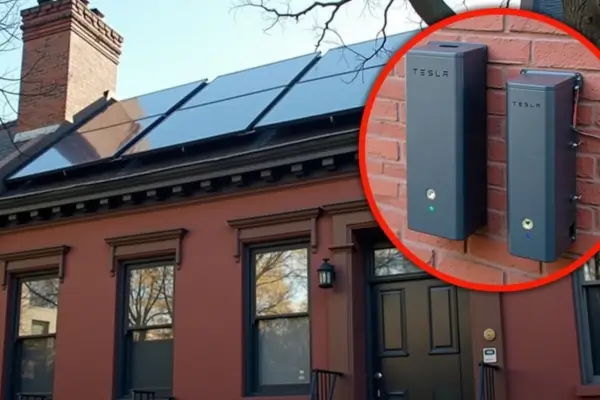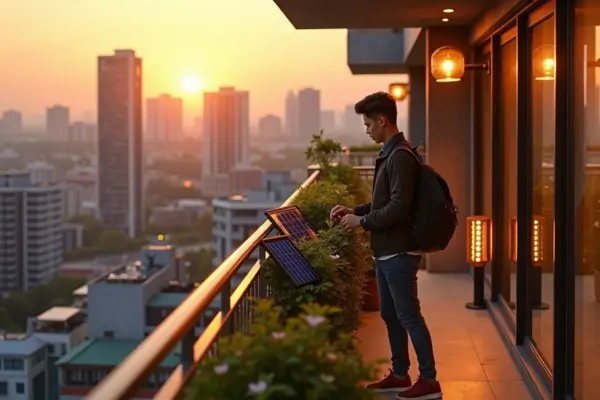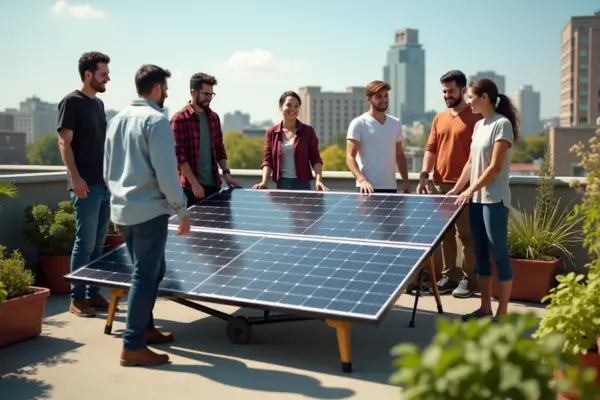Introduction
In an era of rising energy costs, environmental concerns, and unpredictable power grids, more urban dwellers are exploring off-grid energy solutions as a way to take control of their electricity needs. Traditionally associated with remote rural living, off-grid systems are now gaining traction in cities, thanks to advancements in renewable energy technology and smarter storage solutions.
Why Go Off-Grid in the City?
- Sustainability – Reduce your carbon footprint by relying on clean energy sources like solar and wind.
- Energy Independence – Avoid blackouts, utility price hikes, and grid dependency.
- Cost Savings – While initial setup costs can be high, long-term savings on electricity bills make it a smart investment.
Whether you live in a house, apartment, or tiny urban space, this guide will walk you through the best off-grid energy solutions for city living. We’ll cover:
- The different types of off-grid systems (solar, wind, hybrid)
- Key considerations before making the switch
- A step-by-step setup guide
- Real-world examples and future trends
Ready to take the first step toward energy freedom? Let’s dive in!
(Next section: Understanding Off-Grid Energy)
1. Understanding Off-Grid Energy
Living off-grid in a city might sound contradictory—after all, urban areas are synonymous with being “plugged in.” But with modern renewable energy technology, it’s now entirely possible (and increasingly practical) to disconnect from the traditional power grid while living in the heart of a metropolis.
Off-Grid vs. Grid-Tied: What’s the Difference?
- Traditional Grid-Tied Systems: Most urban homes rely entirely on the municipal power grid. Even homes with solar panels often remain grid-dependent, feeding excess energy back to the utility company.
- True Off-Grid Systems: These operate independently, using renewable energy sources (solar, wind, etc.) + battery storage to meet all power needs without any connection to the public electricity network.
Key Benefits of Urban Off-Grid Living
✔ Energy Independence – No more surprise blackouts or fluctuating electricity rates.
✔ Lower Long-Term Costs – After the initial investment, your energy is essentially free (sun and wind don’t send bills!).
✔ Sustainability – Reduce reliance on fossil fuels and shrink your carbon footprint.
✔ Resilience – Extreme weather or grid failures won’t leave you in the dark.
Debunking Common Misconceptions
🚫 “You Need a Huge Property” – Modern compact solar panels and vertical wind turbines work even on rooftops or balconies.
🚫 “It’s Only for Rural Areas” – Urban off-grid systems are becoming more efficient and space-friendly.
🚫 “Batteries Aren’t Reliable” – Today’s lithium-ion and saltwater batteries offer long lifespans and stable storage.
🚫 “It’s Too Expensive” – While upfront costs exist, government incentives and falling tech prices make it more affordable than ever.
The Bottom Line
Going off-grid in the city isn’t just for hardcore survivalists—it’s a smart, sustainable choice for any urbanite looking to take control of their energy future.
(Next up: Types of Off-Grid Energy Solutions for Urban Homes)

2. Types of Off-Grid Energy Solutions for Urban Homes
Living in a city doesn’t mean you’re limited to grid dependence. Thanks to modern technology, urban dwellers now have multiple off-grid energy options—each with unique advantages. Here’s a breakdown of the best systems for city living:
A. Solar Power Systems (The Urban Off-Grid Standard)
1. Rooftop Solar Panels
- Best for: Homes with unshaded roof space
- How it works: Photovoltaic panels convert sunlight into electricity.
- Urban advantages:
- Works even in cloudy climates (modern panels are highly efficient)
- Can be installed on flat roofs or angled setups
- Silent and low-maintenance
2. Portable Solar Generators
- Best for: Renters, apartments, or backup power
- How it works: Compact panels + battery packs (e.g., Jackery, Bluetti)
- Urban advantages:
- No permanent installation needed
- Great for balconies, small yards, or emergency power
- Can be moved or stored easily
3. Solar Battery Storage (e.g., Tesla Powerwall, LG Chem)
- Why it’s essential: Stores excess solar energy for nighttime/cloudy days.
- Urban benefits:
- Sleek, space-saving designs (wall-mounted or underground)
- Seamless backup during outages
B. Wind Energy (For Windy Cities)
Micro Wind Turbines for Urban Use
- Best for: High-rise buildings, open rooftops, or windy coastal cities
- How it works: Small vertical-axis turbines (quieter and more compact than traditional ones).
- Pros & Cons:
- ✅ Works day and night (unlike solar)
- ✅ Can complement solar systems
- ❌ Needs consistent wind (not ideal for sheltered urban areas)
- ❌ Local regulations may restrict installation
C. Hybrid Systems (The Smartest Urban Solution)
1. Solar + Wind + Battery Combos
- How it works: Uses multiple renewable sources to maximize efficiency.
- Urban benefits:
- Balances solar’s daytime power with wind’s 24/7 potential
- More reliable in variable weather
2. Smart Energy Management Systems
- How it works: AI-powered systems (like Tesla Solar Roof + Powerwall) optimize energy use.
- Urban advantages:
- Automatically switches between solar, wind, and battery
- Tracks usage via smartphone apps
D. Alternative Solutions (For the Eco-Innovators)
1. Bioenergy (Biogas from Organic Waste)
- How it works: Converts food scraps/yard waste into methane for cooking/heating.
- Urban potential:
- Great for sustainable apartments/community projects
- Reduces landfill waste
2. Hydrogen Fuel Cells (Emerging Tech)
- How it works: Converts hydrogen into electricity (zero emissions).
- Urban viability:
- Still expensive but promising for future energy storage
- Companies like Toyota and Hyundai are testing home systems
Which One is Right for You?
- For most urbanites: Solar + batteries is the easiest start.
- For windier areas: Add a micro turbine for extra power.
- For tech lovers: Hybrid smart systems offer the most automation.
- For eco-pioneers: Explore biogas or hydrogen for cutting-edge sustainability.
(Next up: Key Considerations Before Going Off-Grid—costs, space, and regulations.)
3. Key Considerations Before Going Off-Grid in the City
Making the switch to off-grid energy is exciting, but urban environments present unique challenges. Before investing in any system, carefully evaluate these crucial factors:
1. Assessing Your Energy Needs
Calculate Your Power Consumption
- Conduct a home energy audit (use tools like Kill-A-Watt meters)
- Track daily kWh usage (check utility bills)
- Prioritize essential loads (fridge, lights, internet) vs. luxury loads (AC, electric vehicle charging)
Urban-Specific Considerations
- Apartment dwellers may need community solar or portable solutions
- High-rise buildings face shared roof space limitations
- Noise restrictions may affect wind turbine options
2. Local Regulations & Zoning Laws
Common Urban Restrictions
- Solar panel bans in historic districts
- Height limits for wind turbines
- HOA rules on exterior modifications
- Permit requirements for battery installations
How to Navigate Them
- Contact your city planning department
- Check local building codes
- Consult with licensed installers familiar with urban permits
- Consider stealth installations (low-profile panels, balcony systems)
3. Space Constraints in Cities
Creative Urban Solutions
| Space Type | Possible Installations |
| Rooftop | Solar panels, micro wind turbines |
| Balcony | Portable solar generators, vertical solar |
| Parking spot | Solar carport + charging |
| Fire escape | Check safety regulations first |
| Community space | Shared solar gardens |
Efficiency Maximizers
- Vertical solar panels for narrow spaces
- Stackable battery systems (like Tesla Powerwall)
- Modular systems that expand over time
4. Upfront Costs vs. Long-Term Savings
Cost Breakdown (Typical Urban Installation)
| System Component | Average Cost | Lifespan |
| 5kW solar panels | $10,000-$15,000 | 25-30 yrs |
| Battery storage (10kWh) | $8,000-$12,000 | 10-15 yrs |
| Micro wind turbine | $3,000-$6,000 | 20 yrs |
| Smart controller | $1,000-$3,000 | 10 yrs |
Financial Payback Timeline
- 5-8 years for solar in sunny climates
- 8-12 years in northern cities
- 20-30% faster ROI with tax credits/incentives
Money-Saving Tips for Urban Dwellers
- Start with a partial off-grid system (just essential circuits)
- Take advantage of:
- Federal solar tax credits (26%)
- Local renewable energy rebates
- Net metering where available
- Consider used/refurbished equipment from reputable dealers
Urban Off-Grid Reality Check
While the independence is appealing, city living requires:
- More precise energy budgeting than rural off-grid
- Creative space utilization
- Potentially higher initial costs per watt due to space constraints
Pro Tip: Many urbanites successfully implement “grid-assisted” hybrid systems – primarily off-grid but with utility as backup during extreme weather.
(Next: Step-by-Step Guide to Setting Up Your Urban Off-Grid System)
4. Step-by-Step Guide to Setting Up an Off-Grid System in the City
Transitioning to off-grid power in an urban environment requires careful planning. Follow this step-by-step roadmap to ensure success:
1. Energy Audit – Know Your Needs
How to Calculate Your Power Consumption
- List all appliances with wattage (check labels or manuals)
- Track daily usage hours for each device
- Use formula:
Wattage × Hours Used Per Day ÷ 1000 = Daily kWh
Example Urban Audit:
- Refrigerator (150W) × 24h = 3.6kWh/day
- Laptop (60W) × 8h = 0.48kWh/day
- LED lights (10W × 5 bulbs) × 5h = 0.25kWh/day
Pro Tip: Use a plug-in energy monitor for accurate readings of variable loads like HVAC systems.
2. Choosing the Right System
Urban System Selection Guide
| Situation | Recommended Setup |
| Small apartment | Portable solar generator + battery |
| Rooftop access | Solar panels + Powerwall |
| Windy high-rise | Vertical-axis wind turbine supplement |
| Shared building | Community solar subscription |
| Tech-heavy home | Hybrid solar-wind with smart controller |
Key Decision Factors:
- Available space (roof, balcony, walls)
- Local climate (sunny vs. windy)
- Budget constraints
- Aesthetic considerations (HOA rules)
3. Installation – DIY or Professional?
DIY Installation (For Small Systems)
✔ Best for: Portable solar, balcony setups
✔ Cost Savings: 30-50% cheaper
✔ Requirements:
- Basic electrical skills
- Understanding of local codes
- Proper safety equipment
Professional Installation (Recommended For)
✔ Whole-home systems
✔ Roof-mounted solar
✔ Grid-tie/hybrid systems
✔ Permitting and inspections
Urban Installation Challenges:
- Working around existing utilities
- Limited roof access in apartments
- Noise restrictions during installation
4. Battery Storage & Backup
Urban Battery Solutions
- Lithium-Ion (Tesla Powerwall, LG Chem)
- Compact, wall-mounted
- 10-15 year lifespan
- Saltwater Batteries
- Non-toxic, apartment-friendly
- Lower energy density but safer
- Stackable Modular Systems
- Expand as needs grow
- Ideal for tight spaces
Backup Strategy:
- Size batteries for 3 days of autonomy (urban smog/rain)
- Include manual transfer switch for critical loads
- Consider LPG generator backup for emergencies
5. Maintenance & Upkeep
Urban System Maintenance Checklist
| Task | Frequency | Urban Adaptation |
| Panel cleaning | Quarterly | Use telescopic cleaners for high windows |
| Battery check | Monthly | Smart apps for remote monitoring |
| Connection inspection | Biannually | Hire pros for hard-to-reach areas |
| Wind turbine bearings | Annual | Vertical turbines need less maintenance |
Troubleshooting Common Urban Issues:
- Pigeon problems: Install mesh guards
- Shading issues: Use micro-inverters
- Limited sun: Adjust panel angles seasonally
Implementation Timeline
- Planning Phase (2-4 weeks)
- Energy audit, system design, permits
- Installation (1-3 days for small systems)
- Testing (1 week of monitoring)
- Optimization (Ongoing tweaks)
Final Tip: Start with a small pilot system (e.g., just powering your refrigerator) before going fully off-grid.
(Next: Real-Life Examples of Urban Off-Grid Living)

5. Real-Life Examples & Case Studies: Off-Grid Living in the City
1. Urban Homes Successfully Running Off-Grid
Case Study 1: The Brooklyn Brownstone (Solar + Battery)
- Location: New York City
- System: 8kW rooftop solar + 4 Tesla Powerwalls
- Key Features:
- Powers entire 3-bedroom home year-round
- Survived 5-day blackout during winter storm
- Uses vertical solar panels on side walls
- Savings: $3,200/year on electricity bills
*”We haven’t paid a ConEd bill in 3 years. The system paid for itself in 6 years with tax credits.” – Homeowner Mark T.*
Case Study 2: Tokyo Micro-Apartment (Portable Solar)
- Location: 20m² studio in Shibuya
- System:
- 2 x 200W foldable solar panels on balcony
- Bluetti AC200P battery station
- Solar-powered mini-fridge and induction cooker
- Innovation:
- Uses solar curtains for passive heating
- Swapped AC for DC-powered fans and lights
2. Creative Small-Space Solutions
Apartment Hack: The “Closet Power Plant”
- Location: Chicago high-rise
- Solution:
- Stacked 3 x EcoFlow Delta batteries in utility closet
- Fire escape solar panels (removable design)
- Powers fridge, router, and essential devices
*”My 600W system keeps my home office running during outages. Landlord approved because it’s temporary.” – Freelancer Sarah K.*
Urban Community Solution: The Rooftop Solar Co-op
- Location: Berlin apartment complex
- Model:
- 20 households share 15kW solar array
- Blockchain-tracked energy distribution
- Battery-sharing program for nighttime use
3. Extreme Urban Off-Grid: The Shipping Container Home
- Location: Los Angeles backyard
- System:
- Vertical wind turbine + solar roof
- Composting toilet and rainwater capture
- Vehicle-to-home (V2H) charging with EV battery
*”My 200 sq ft home produces 110% of its energy needs. The city initially said it was impossible.” – Architect Diego M.*
4. Temporary Urban Off-Grid (For Renters)
Solution:
- Rollable solar mats stored under bed
- “Battery suitcase” (Jackery 1000 for essentials)
- Window-mounted micro wind turbines
*”I move every 2 years. My entire power system fits in my hatchback.” – Digital nomad Priya R.*
Key Takeaways From These Cases
- Space is no limit – Even fire escapes can host solar
- Start small – Many began with just 1 battery + panel
- Community solves scale – Shared systems cut costs
- Hybrid is king – Most combine 2+ energy sources
(Next: Challenges & How Urban Dwellers Overcome Them)
6. Challenges & How to Overcome Them in Urban Off-Grid Living
While liberating, urban off-grid energy systems come with unique hurdles. Here’s how real city dwellers are solving these problems:
1. Limited Space for Solar/Wind Setups
Creative Space Solutions
✅ Vertical Solar Arrays
- Mount panels on walls, railings, or window frames
- New bifacial panels generate power from both sides
✅ Balcony Wind Turbines
- Vertical-axis turbines (e.g., Aurea Technologies) need just 1m²
- Some produce 500W even at low wind speeds
✅ Shared Community Systems
- Rooftop cooperatives where multiple units share one solar array
- Parking lot solar canopies double as EV charging stations
Real Example: A Seattle apartment resident powers 80% of needs using 3 x 100W panels on a south-facing fire escape (with landlord approval).
2. High Initial Investment
Cost-Slashing Strategies
💰 Phased Installation
- Start with one critical circuit (e.g., refrigerator + lights)
- Expand system as budget allows
💰 Incentive Stacking
- Combine:
- 26% Federal Solar Tax Credit
- Local utility rebates (e.g., NY offers $0.20/W)
- Property tax exemptions
💰 Alternative Financing
- Solar leases ($0-down options)
- Energy-efficient mortgages
- Group purchases with neighbors for bulk discounts
Cost Hack: A Chicago couple cut battery costs by 50% using refurbished Tesla EV batteries with a professional BMS (Battery Management System).
3. Extreme Weather Challenges
Urban-Specific Weatherproofing
🌪️ For Hurricane-Prone Areas:
- Use hurricane-rated solar mounts
- Install quick-release panels for pre-storm removal
❄️ For Cold Climates:
- Heated panels prevent snow buildup
- Lithium batteries with internal warmers
☁️ For Low-Sun Cities:
- Hybrid solar-wind systems compensate for cloudy days
- Dynamic panel tilting (manual or automatic) to chase sunlight
🌆 For Air Pollution/Smog:
- Self-cleaning nano-coated panels resist dust
- More frequent cleaning schedules (every 2 months)
Innovation Spotlight: A Boston high-rise uses heated sidewalk-style elements under rooftop panels to automatically melt snow.
Bonus: Overcoming Regulatory Hurdles
📜 Permit Navigation Tips:
- Classify systems as “temporary” when possible
- Partner with local green energy nonprofits for advocacy
- Use UL-listed equipment to satisfy safety concerns
The Resilience Payoff
While challenging, overcoming these obstacles means:
🔋 No more blackout anxiety
💵 Long-term immunity to rate hikes
🌎 Climate-change-proof living
(Next: The Future of Urban Off-Grid Energy – Emerging Tech & Trends)

7. Future of Urban Off-Grid Energy: Trends Shaping City Living
The urban energy revolution is accelerating. Here’s what’s coming next for off-grid city dwellers:
1. Cutting-Edge Renewable Tech
Solar Innovations
☀️ Solar Skin Panels
- Custom designs matching roof aesthetics (perfect for HOAs)
- MIT’s thin-film PV achieves 90% transparency for windows
☀️ Nighttime Solar
- Stanford’s anti-solar cells generate 50W/m² from radiative cooling
Wind Energy Breakthroughs
🌪️ Vortex Bladeless Turbines
- Silent, 3m-tall poles generating power from vibrations
- Ideal for apartment balconies
🌪️ Building-Integrated Wind
- Airiva’s vertical turbines blend into facades
- Each unit powers 3-5 apartments
Energy Storage Leaps
🔋 Graphene Supercapacitors
- Charges in seconds, lasts 100,000 cycles
- Skeleton Tech’s prototypes entering consumer market
🔋 Sand Batteries
- Stores excess energy as heat (600°C) for winter use
- Already deployed in Finnish cities
2. Government Policies & Incentives
Current Global Support Programs
| Country | Key Initiative | Urban Impact |
| USA | Solar Investment Tax Credit (30% until 2032) | Covers batteries since 2023 |
| Germany | KfW 270 Renewable Energy Loan | 0% interest for off-grid systems |
| Japan | Net Zero Energy Building Mandate | Requires solar on all new urban construction |
| Australia | Battery Subsidy Program | $3,000 rebates for urban installations |
Emerging Policy Trends
- “Right to Solar” laws overriding HOA restrictions
- Virtual power plant (VPP) incentives paying urbanites for excess energy
- Zoning reforms allowing micro wind in cities
Case Study: Barcelona’s Solar Ordinance requires all buildings >250m² to install solar – creating Europe’s largest urban renewable network.
3. Smart Grids & Decentralized Energy
The Peer-to-Peer Energy Revolution
⚡ Blockchain Energy Trading
- Brooklyn’s LO3 Energy lets neighbors sell solar power directly
- Power Ledger apps enable tokenized energy swaps
⚡ AI-Optimized Microgrids
- Google’s DeepMind reduces urban energy waste by 40%
- NextEra’s self-healing grids prevent blackouts
Vehicle-to-Grid (V2G) Integration
🚗 EVs as Home Batteries
- Ford F-150 Lightning can power a home for 3 days
- NYC pilot programs pay EV owners for grid balancing
Urban Energy Horizon: 2030 Preview
- Solar-paved bike lanes charging e-bikes
- Algae bioreactor façades generating biofuel
- Quantum dot windows producing 100W/sq.ft
- Municipal “energy sharing” mandates requiring new developments to be off-grid capable
Preparing for the Transition
- Future-proof current systems with hybrid-ready inverters
- Monitor policy changes through resources like DSIRE
- Join local energy co-ops to leverage group buying power
(Next Steps: Conclusion & Your Off-Grid Action Plan)
Conclusion:
Your Path to Urban Energy Independence
Key Takeaways
- Off-grid living is possible in cities – From solar balconies to micro wind turbines, urban spaces can harness renewable energy creatively.
- Start small and scale up – Begin with portable solar or a single off-grid circuit before going fully independent.
- Hybrid systems are the future – Combining solar, wind, and smart storage maximizes efficiency in limited urban spaces.
- Policy and tech are on your side – Government incentives and breakthroughs in energy storage make off-grid living more accessible than ever.
- Resilience pays off – Energy independence means no more blackouts, rising utility costs, or reliance on unstable grids.
Take the First Step Today
You don’t need to go completely off-grid overnight. Here’s how to start:
- For renters: Try a portable solar generator (like Jackery or Bluetti) for essential devices.
- Homeowners: Begin with a small rooftop solar array + battery (even 2-3kW can make a dent).
- Community action: Rally neighbors for a shared solar or microgrid project.
Your Call-to-Action
🔹 This week: Conduct a home energy audit (use your utility bill or a smart plug monitor).
🔹 Next month: Get quotes from local solar/wind installers or research DIY kits.
🔹 This year: Install one off-grid system component (solar panels, battery, or efficiency upgrades).
Final Thought
Cities were once energy deserts—dependent on distant power plants and fragile grids. But today, you can reclaim control. Whether you’re motivated by savings, sustainability, or security, the tools exist to build your own urban energy oasis.
The best time to start was yesterday. The next best time is now.
(Want personalized advice? Drop your city/living situation in the comments, and we’ll suggest your ideal first step!)



